Information Absorber
It is amazing how strong remains the belief in the saving power of communication, in the force of critical arguments, the might of truth and the right to expression. Belief in the public sphere, as a playground for this free communication. Just as it were enough to reveal the facts, expose the injustice, point out the contradictions in the system. The change, the progress should result directly from this critical action. The Information Absorber is supposed to reveal a hidden and less friendly aspect of the public sphere – its capacity of neutralizing of every massage by adding it up to other cumulated messages, which form a chaotic information patchwork rather than contradict one another. Information doesn’t follow the logic of truth. It plays an important role in the reproduction of the Spectacle…
Panuje przekonanie, że aby coś zmienić, ulepszyć, rozwiązać jakiś problem, należy powiedzieć głośno, co jest „nie tak”, poddać dane zjawisko uzasadnionej krytyce, wykazać nieskuteczność czy sprzeczności określonych zachowań itd. Na tym zdaje się polegać rola krytyki w świecie opartym na wierze w komunikację i zdroworozsądkową binarną logikę, która pomaga zdefiniować same sprzeczności.
Pojawia się jednak zasadnicze pytanie – czy system komunikacji obecny w przestrzeni publicznej głównie za sprawą mediów rzeczywiście rządzi się zasadą sprzeczności? Czy nie jest to rodzaj złudzenia, w które nadal wierzymy?
Zadziwiające, jak silna pozostaje wciąż wiara w zbawczą moc komunikacji, w skuteczność argumentu i krytyki, w siłę prawdy i święte prawo do ekspresji. Oraz w przestrzeń publiczną jako przestrzeń, w której odbywać się ma owa nieskrępowana komunikacja. Information Absorber ma wydobyć na jaw mniej sympatyczne oblicze przestrzeni publicznej – jej zdolność do neutralizowania wszelkiego przekazu przez dodanie go do innych, skumulowanych i tworzących chaotyczną mozaikę komunikatów. Przekaz zostaje przez nie jednocześnie zagłuszony i zwielokrotniony, tak że w urywkach, na które się rozpada, odbija się echem dyskurs anonimowy, należący do wszystkich i do nikogo…
Information Absorber to projekt, który bada entropię i autodestrukcję komunikacji. W formie fizycznej jest to zmaterializowany proces nieustannego rozpadu zorganizowanej, spójnej, racjonalnej mowy w bezgraniczny szum strumienia informacji, który stał się naszym signum temporis. Zdeformowany i zakleszczony w czasie rzeczywistym i rzeczywistej przestrzeni. Pochłaniacz informacji jest krytyczną reakcją na coś, co można by nazwać „utopią komunikacji”. Pokazuje, że „wypowiadanie się” i uczestnictwo w sferze publicznej może nie wystarczyć, jeśli mamy na uwadze złożony system medialnej akumulacji i neutralizacji każdego możliwego (także krytycznego) przekazu. Zamiast wyidealizowanych mówiących jednostek, przywołuje Lewiatana sfery publicznej, potwora ery informacji, politycznego medium, które mówi samo za siebie.
Information Absorber jest efektem zbiorowego, interdyscyplinarnego wysiłku artystek i artystów. Ale również i odbiorców, którzy w głównej mierze budują treść instalacji. (W trakcie samych przygotowań projektu udało nam się zebrać bazę danych zawierającą około 100 wypowiedzi w 20 językach.)
The Information Absorber is conceived as a creation of many different subjects and based on the idea of blurred authorship. It is a product of collective, interdisciplinary effort of artists, musicians, engineers, constructors. The project requires engagement and commitment of the participants. (During the building process we have managed to collect already a data base with around 60 statements in 20 languages.) Every individual statement will be remixed into the public noise, so that individual authorship of communiqués will blur and dissolve. Every participant will be anonymous composer (source of sound samples) and musician (controlling through his / her voice information stream).
It poses a question of the artist’s public role – does he still have a right to believe in communication, in the saving power of her public artistic statement? Artist is perceived as an information stream engineer rather than rational individual, working with interfaces of public sphere instead of trying to communicate preconceived notions and ideas.
The project explores the entropy, self-destruction of communication. It is an ongoing process of dissolution of organized, coherent, rational speech into a boundless noise of information stream (the emblematic figure of our times), deformed and jammed in real time and real space.
The Information Absorber is a critical reaction on something that might be called “communication utopia”. It shows that “having one’s say” and participating in public sphere may just not be enough if we mind the complex media system of accumulation and neutralization of every possible (also critical) massage.
It poses the problem of destruction of individual signal or voice which dissolves into the multiplicity of information streams. Instead of idealized speaking individuals it evokes the Leviathan of the public sphere, a monster of information age, political medium which speaks for itself.
noise
Information Absorber to obiekt w przestrzeni publicznej w formie interaktywnej instalacji dźwiękowej.
Projekt ten powstał w 2012 roku na zlecenie Métamatic Research Initiative
i był wystawiany w 2013/2014 w ramach kolekcji w Jean Tinguely Muzeum w Bazylei obok prac Mariny Abramovic, Ranjit Bhatnagar, Johna Bocka, Olafa Breuninga, Thomasa Hirschhorna, Jona Kessler, Pors&Rao, Jao Simoes i Brigitte Zieger
http://www.metamaticresearch.info/
Information Absorber is an object in public space, with an interactive sound installation as the most essential part.
This project was commissioned by Métamatic Research Initiative in 2012
and was exhibited in 2013/2014 as a collection of work at Jean Tinguely Muzeum in Basel among such artist like Mariny Abramovic, Ranjit Bhatnagar, Johna Bocka, Olafa Breuninga, Thomasa Hirschhorna, Jona Kessler, Pors&Rao, Jao Simoes and Brigitte Zieger






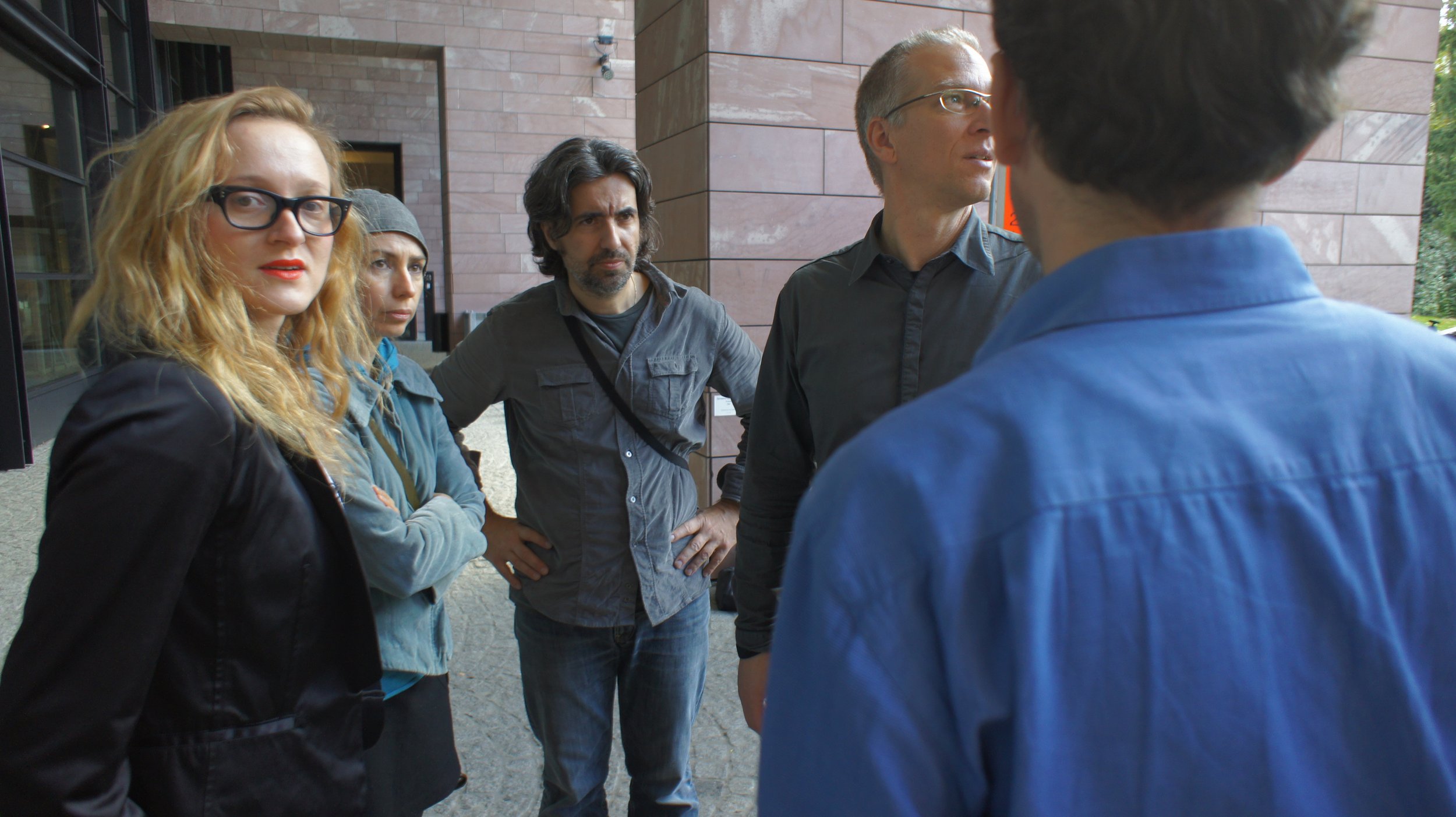
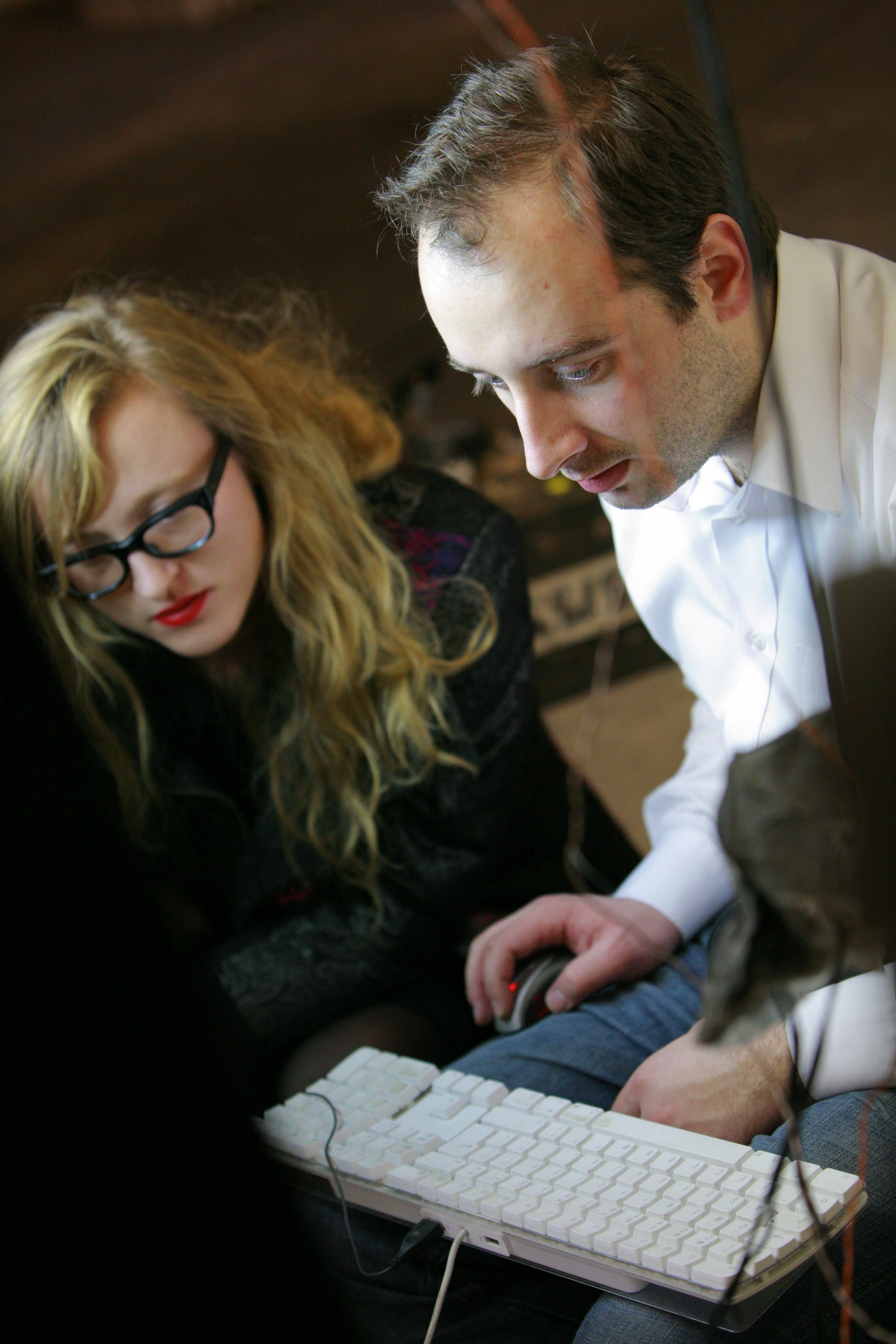





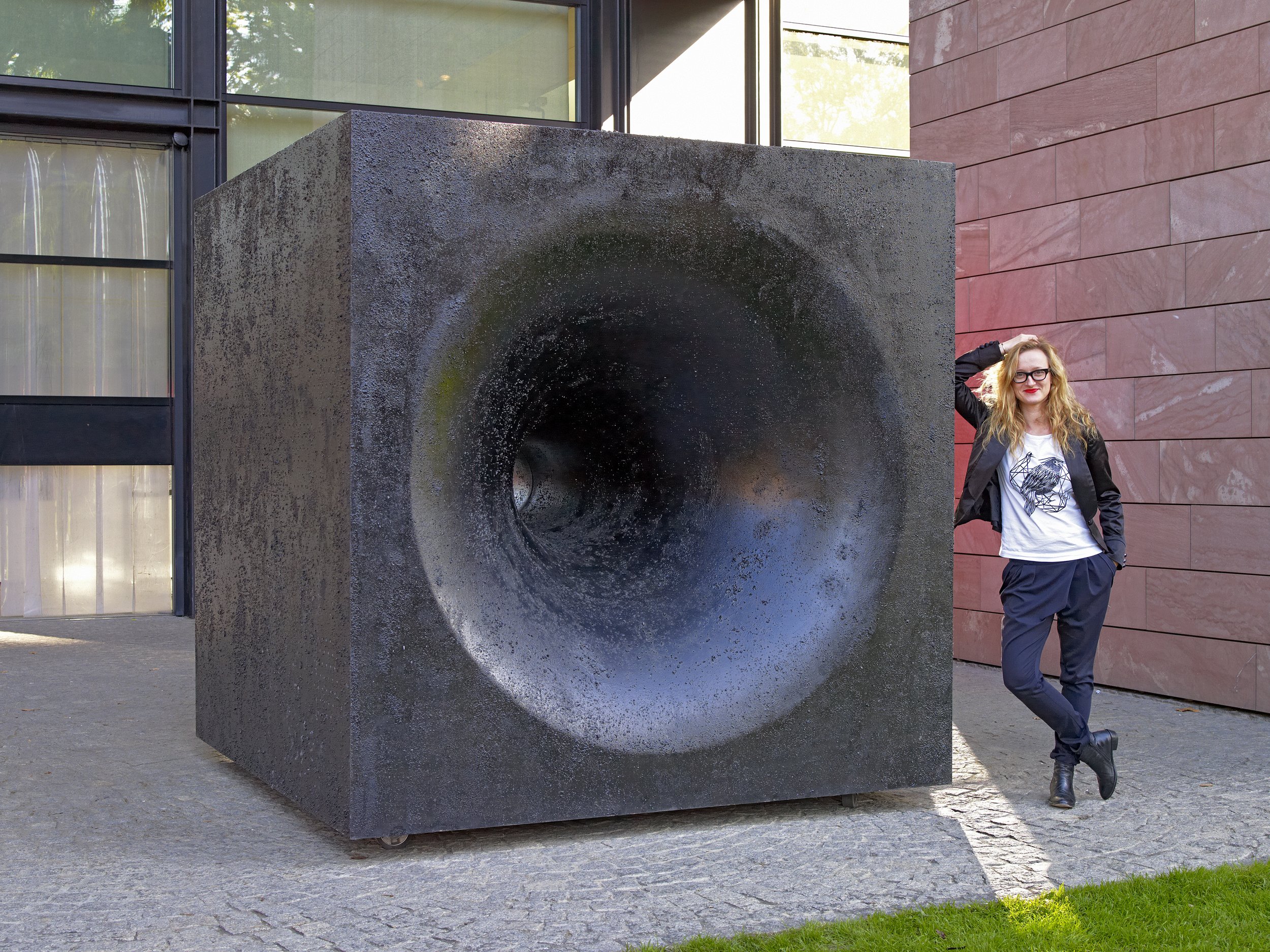












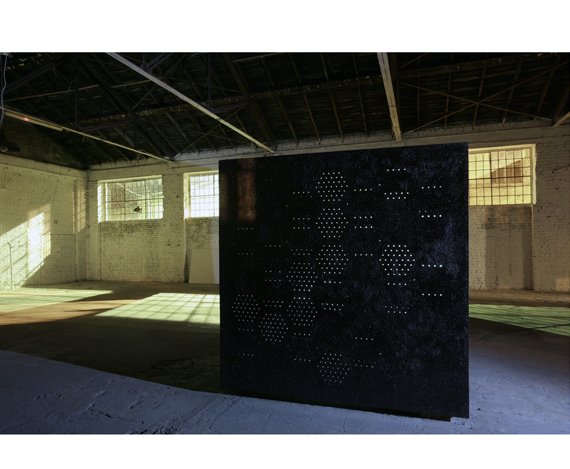



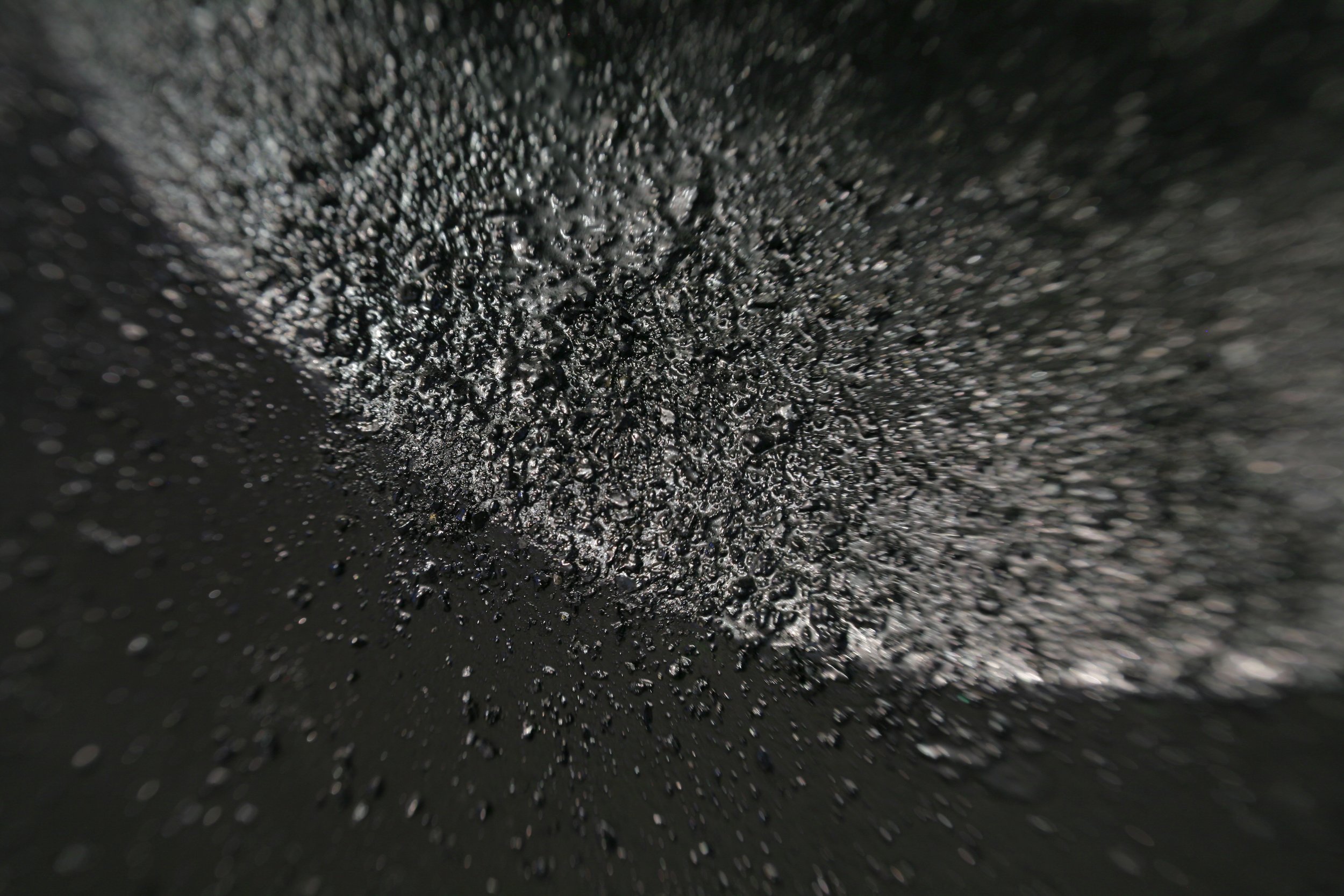
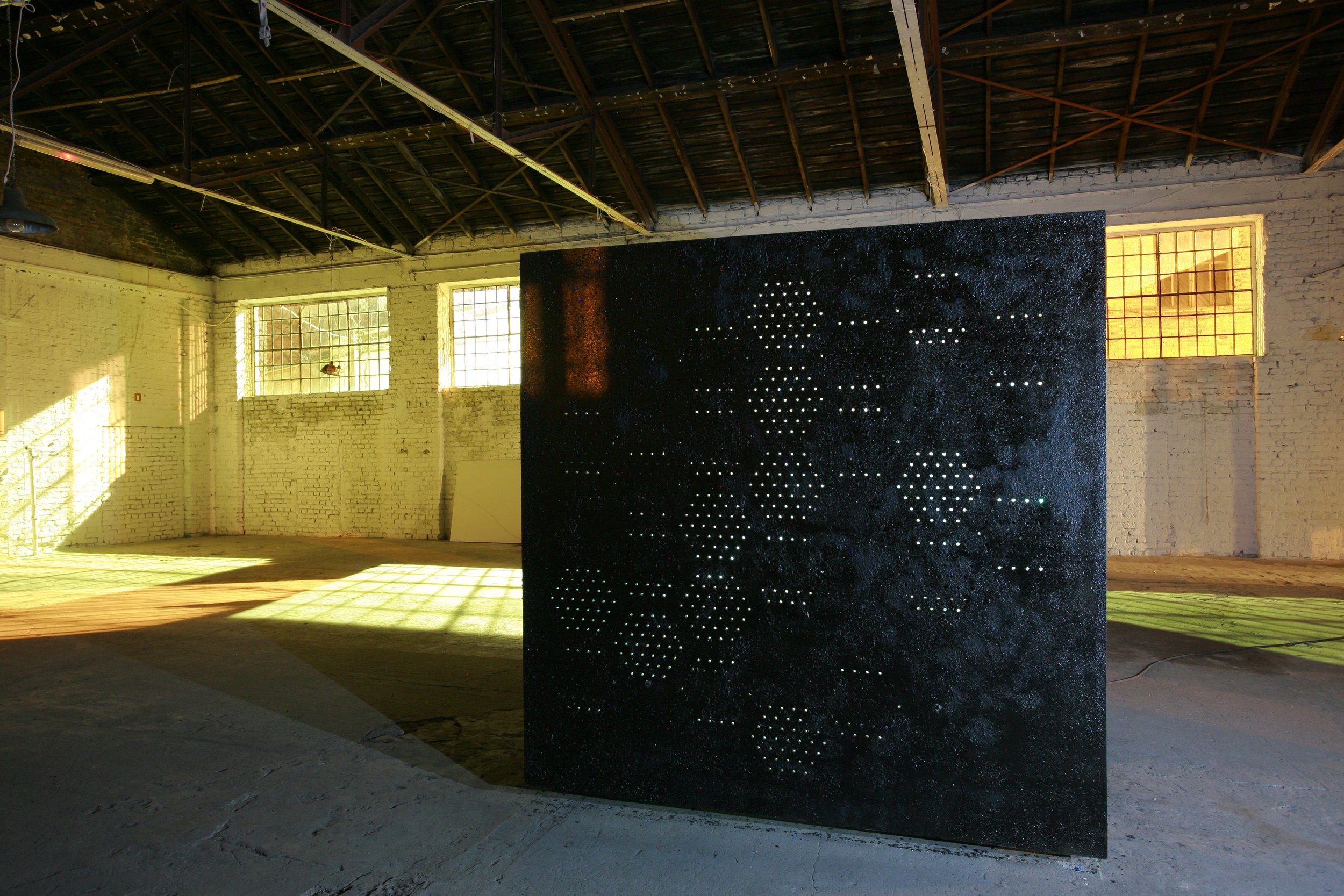

CREDITS
ZESPÓŁ:
Aleksandra Hirszfeld (koncepcja)
Magda Sobolewska (menedżerka)
Gosia Kuciewicz and Simone de Iacobis (architekci)
Katarzyna Kuźmińska (makiety)
Mateusz Adamczyk (inżynier dźwięku)
Mateusz Brzozowski (programista)
Maciek Bończak (dokumentalista)
Leszek Nowosielski (wykonawca)
Agata Kawecka (zdjęcia)
TEAM:
Aleksandra Hirszfeld (conception)
Magda Sobolewska (menager)
Gosia Kuciewicz and Simone de Iacobis (architects)
Katarzyna Kuźmińska (models)
Mateusz Adamczyk (sound engineer)
Mateusz Brzozowski (programmer)
Maciek Bończak (documentary film-maker)
Leszek Nowosielski (constructor)
Agata Kawecka (photos)
dr Michał Herer about Information Absorber:
W jakim stosunku pozostaje sztuka do swej własnej aktualności? Każda forma „estetyzmu” zdaje się rozluźniać ten związek albo przynajmniej – jak słynny Baudelaire’owski „malarz życia codziennego” – poza tym, co ulotne, przynależne do „mody” wydobyć ów inny, pozaczasowy aspekt piękna, do którego ma aspirować wszelka sztuka godna tego miana: „wieczne odsłonić w przemijającym”[1]. Wyjście „poza czas” może jednak mieć także inny sens, bliższy nietzscheańskiej niewczesności: działać „wbrew czasowi i przez to na czas, […] na korzyść czasu, który przyjdzie”[2] Tym razem nie chodzi o doznanie, za pośrednictwem estetycznej formy, bezczasowej idei piękna, lecz o pewną strategię wobec czasu, o pewien specyficzny sposób bycia sztuki w czasie, a zarazem przeciw niemu. Przede wszystkim przeciw chwili obecnej, a dzięki temu, być może, za czymś co skrywa przyszłość, co jednak nie stanowi prostego rezultatu tendencji drążących chwilę obecną, lecz – przeciwnie – może być tylko wywalczone, a jeśli się wydarzy, to tylko dzięki jakiemuś odchyleniu toru, po którym porusza się świat, jego fatalnej trajektorii.
Inaczej niż w modelu estetycznym, artysta jest tu nie tyle tym, kto doznaje i pozwala doznawać, ile kimś w rodzaju lekarza, diagnosty. W kulturze Zachodu przynajmniej od czasu Romantyzmu (choć w gruncie rzeczy jest to motyw dużo starszy) wielką wagę przywiązuje się do związku między twórczością a chorobą. Wynika to właśnie z estetycznego prymatu doznania. Choroba, szaleństwo jest tym, co ułatwia albo wręcz umożliwia „widzenie” istotnej rzeczywistości, rzadziej mówi się natomiast o artyście jako lekarzu, nie w sensie uzdrowiciela albo cudotwórcy (to figury wciąż bliskie koncepcji romantycznej albo – szerzej – idealistycznej), lecz w sensie kogoś, kto potrafi trafnie rozpoznać stan pacjenta, a następnie sprzyjać procesowi jego samo-leczenia. Tymczasem do sztuki i artystów w ogóle można odnieść to, co Gilles Deleuze pisał swego czasu o literaturze i pisarzach: „pisarz jako taki jest nie tyle pacjentem, ile raczej lekarzem, lekarzem samego siebie i świata. Świat to zbiór symptomów […], literatura zaś jawi się jako przedsięwzięcie zdrowia”[3].
Tego typu strategię można oczywiście wiązać z imperatywem sztuki krytycznej, pod warunkiem wszelako, że właściwie rozumiemy sens pojęcia krytyki, odsyłający do sytuacji kryzysu. Kluczowym elementem diagnozy jest uchwycenie momentu przesilenia, punktu krytycznego mogącego stać się punktem zwrotnym w procesie zdrowienia. Po Kancie banałem jest stwierdzenie, że krytyka w głębszym, filozoficznym znaczeniu nie sprowadza się do prostego odrzucenia, że jest badaniem. Jednak dopiero wspólna etymologia krytyki i kryzysu rzuca światło na naturę owego badania, na jego związek nie tyle – jak u Kanta – z ustalaniem granic, ile z różnicowaniem i rozstrzyganiem.
Pochłaniacz informacji nie jest fenomenem estetycznym, lecz maszyną krytyczną w wyżej zarysowanym sensie, a ściślej: urządzeniem meta-krytycznym, problematyzującym samą krytykę i krytyczność, w polu sztuki i poza nim. Swoim działaniem stawia fundamentalne pytanie: kiedy krytyka ma charakter rozstrzygający, w jakich okolicznościach robi różnicę? Jeśli tradycyjne (Kantowskie) pytanie krytyczne dotyczy warunków możliwości, aktualne pytanie o sztukę albo pytanie o sztukę jako diagnozę aktualności odsyła do warunków, pod jakimi może ona funkcjonować jako krytyczna, rozróżniać, oddzielać i – w sprzyjających okolicznościach – wspomagać ruchy bifurkacji albo procesy przesilenia. Można je, oczywiście postawić odwołując się do dyskursu teoretycznego, można jednak zrobić to także środkami samej sztuki. Tak właśnie pracuje Hirszfeld – chodzi o myślenie, problematyzowanie, kwestionowanie sztuką, za pomocą jej narzędzi. Pochłaniacz informacji jest maszyną meta-krytyczną, i jako taka wywołuje (a w każdym razie może wywoływać) efekty podobne do tych, jakie wywołuje teoria, osiąga to jednak to poprzez inter-akcję raczej niż wykładanie argumentów.
Efekt ów polega na zakwestionowaniu pewnego istotnego przekonania, na którym wspiera się ideologia „społeczeństw informacyjnych”: im więcej informacji, tym więcej emancypacji, im więcej uczestnictwa, tym więcej demokracji. Wprawdzie już od jakiegoś czasu narzekamy na „tabloidyzację” mediów i powszechny „infotainment”, zasadnicze przekonanie o zbawczej, krytycznej mocy informacji, trzyma się jednak mocno, także w sztuce. Sztuka krytyczna przez długi czas utożsamiana była z aktem demaskowania – jej krytyczna funkcja miała się kryć właśnie w odsłanianiu tego, co niejawne, skrywane przez interesy władzy, kapitału itd. Nadeszła jednak pora, by zastanowić się nad owymi pewnikami. Na gruncie teorii uczynił to nie tak dawno Jean Baudrilliard, mówiąc o „implozji” jako podstawowym mechanizmie anihilującym późno kapitalistyczną rzeczywistość, albo wręcz rzeczywistość jako taką, i skazującym ją na byt „symulowany”. „Instytucje samoczynnie implodują w wyniku nadmiernej ilości rozgałęzień, przeciążeń układów sprzężenia zwrotnego i zbytnio rozbudowanych obwodów kontrolnych”[4]. „Co, jeśli nowoczesny świat hiper-komunikacji pogrążył nas nie tyle w bezsensie, ile w stanie straszliwego nasycenia sensu, całkowicie wchłoniętego przez swe własne zwycięstwo?”[5]. Tam, gdzie wszystko staje się informacją, informacja jako taka imploduje i staje się swoją własną symulacją. Tam, gdzie przestaje działać zasada odniesienia albo sensu, wiadomości nie mogą nawzajem się dementować, a jedynie dodają się do siebie, podlegając prawu nieskończonej akumulacji. Przestaje być możliwa krytyka jako demaskowanie fałszu i machinacji władzy, przynajmniej o tyle, o ile samo owo odsłanianie, jako takie, miałoby robić różnicę, dementować ideologię władzy, dyskurs jej samo-uzasadnień. Nasze odpowiedzi na pytanie „co jest nie tak z tym światem?” zostają wchłonięte, zmielone i wyplute w postaci informacyjnego szumu. Nie mają już żadnej mocy, nawet jeśli są „słyszalne” w przestrzeni publicznej, wpisują się w demokratyczną „debatę” itd. Już sam fakt, że pozwala się nam mówić, powinien obudzić naszą czujność, skłonić do podejrzenia, że być może nasza mowa, nasze uczestnictwo w dyskusji, nasz krytyczny głos w istocie nie mają żadnego znaczenia, że tradycyjny dyskurs krytyczny, a wraz z nim tradycyjnie rozumiana sztuka krytyczna, zostały wchłonięte i zneutralizowane przez integralny system symulacji.
Czy meta-krytyczne badanie warunków możliwości krytyki nie wykazuje zatem, że w istocie jest ona niemożliwa? Diagnoza, jaką stawia Information Absorber, raz jeszcze wydaje się zbliżona do tej znanej (co nie znaczy: przyswojonej) z pism Baudrillarda. Epoka krytyki jako demaskacji, wraz z moralną i poznawczą wyższością dyskursu krytycznego, dobiegła końca. Dyskurs krytyczny implodował na skutek swej własnej hipertrofii: „ Współczesny świat wymyka się krytyce o tyle, o ile pozostaje z konieczności w nieustannym ruchu odczarowania, wyzbywania się złudzeń, rozpraszania I rozpadu, tym samym ruchu, który pcha go ku porządkowi i absurdalnemu konformizmowi […] Iluzja krytyczna, pozbawiona kolejnych ofiar, które mogłaby jeszcze pochłonąć, poczęła pożerać samą siebie”[6]. Stwierdzenie tego impasu nie jest jednak ostatnim słowem. Co prawda nie pada żadne słowo dodatkowe, wszystkie (krytyczne) słowa zostają pochłonięte przez maszynę i wyrzucone w postaci nie-znaczącego szumu, a mimo to pojawia się tu pewna wartość dodana. Wiąże się ona nie tyle – raz jeszcze – z demaskacją, ile z poszukiwaniem punktu krytycznego. Jest to oczywiście punkt albo moment samej implozji, w którym nadmiar informacji albo krytyki przeradza się w swoje przeciwieństwo, ale także – być może – poprzez powtórzenie samego procesu wchłonięcia i przejścia w fazę symulacji, przez jego odegranie, zainscenizowanie, coś, co pozwala w samym tym procesie zlokalizować jakieś nowe pęknięcie. Rzeczywistość integralna wydaje się nie mieć żadnej rysy, w swoim aspekcie informacyjnym jest czystą ekstazą komunikacji. Co stanie się jednak wówczas, gdy odegramy do końca ową ekstazę, w której zatraca się wszelki sens. Może wtedy – choć nie musi (nie działa tu żadna teleologia) dojść do kolejnego przesilenia, w wyniku którego czysta pozytywność sama ujawni swój mroczny rewers. To właśnie ma na myśli Baudrillard, kiedy mówi, że potrzeba nowego rodzaju myśli, myśli radykalnej, która dystansuje tradycyjnie rozumianą myśl krytyczną, a dokładniej: polega właśnie na ruchu dystansowania samej, przechodzącej w swą własną symulację rzeczywistości[7]. Myślenie sztuką Aleksandry Hirszfeld ma być właśnie myśleniem radykalnym, dystansującym – nie tyle demaskującym, ile poszukującym przesileń i kryzysów, prowokującym je. Jest tak już w przypadku Pochłaniacza, ale w jeszcze większym stopniu obiecują to przygotowywane przez nią dwie kolejne odsłony tryptyku, który inauguruje ta praca. Za każdym razem chodzi o wydobycie negatywności z tego, co na pozór integralnie pozytywne. Bo czy może być coś bardziej pozytywnego niż pragnienie i pieniądz, wraz z informacją składające się na świętą trójcę ponowoczesności. Zatopienie sensu w szumie informacyjnym, wygaszenie pragnienia, nieodwracalna anihilacja wirtualnego pieniądza – czy są to jeszcze działania krytyczne, czy akty poetyckiego terroryzmu?
Michał Herer
[1] Ch. Baudelaire, Malarz życia nowoczesnego, przeł. J. Guze, słowo/obraz terytoria, Gdańsk 1998, s. 23; por. tamże, s. 13: „piękno składa się z elementu wiecznego, niezmiennego, którego ilość jest nader trudna do określenia, i elementu zmiennego, zależnego od okoliczności, takich jak moda, moralność, wzięte oddzielnie lub wszystkie razem”.
[2] F. Nietzsche, Niewczesne rozważania, przeł. L. Staff, Wydawnictwo Zielona Sowa, Kraków 2003, s. 64 .
[3] G. Deleuze, Critical And Clinical, transl. by D.W. Smith and M.A. Greco, Verso, New York, 1998, s. 3.
[4] J. Baudrillard, Spisek sztuki, przeł. S. Królak, Sic!, Warszawa 2006, s. 91.
[5] Jean Baudrillard, The Ecstasy of Communication, transl. by B. & C. Schutze, Semiotexte(e), New York, 1988, p. 103; por również tenże, W cieniu milczącej większości, przeł. S. Królak, Sic!, Warszawa 2006, s. 50: „to nie sens ani jego nadmiar sprawiają gwałtowną rozkosz; to jego neutralizacja nas fascynuje”.
[6] J. Baudrillard, Zbrodnia doskonała, przeł. S. Królak, Sic!, Warszawa 2008, s. 88, 38.
[7] Por. tamże, s. 82.
What is the relation between art and the actual? Every form of “aestheticism” seems to loosen this tie or – as it was in case of Baudelaire’s “painter of modern life” – at least provoke a search for another, timeless aspect of the Beauty, behind its fugitive appearance resulting from circumstances or fashion: an attempt to „distil the eternal from the transitory”[1]. Going “beyond time” may, however take a different form, closer to the Nietzschean untimelyness: “acting counter to our time, and thereby acting on our time and, let us hope, for the benefit of a time to come”[2]. In that case, it is not a question of aesthetic “sensation”, but one of strategy towards one’s own time, a mode of art’s being-in-time, and… counter to it. Most of all, it means being against the present, and “thereby” with something that awaits in the future, but doesn’t simply result from the present tendency, something that, in opposite, may only be won in a battle, appear thanks to an unexpected declination of the world’s fatal trajectory.
Unlike in aesthetical model, the artist is, here, not the one who experience and make others experience or sense, but rather a diagnostician. In the history of Western culture, at least since the romantic revolution (even though the figure is older), we give much importance to the coincidence of creativity and sickness. One of the reasons for that is the primacy of sensation. Sickness, madness is something that facilitates “vision”, or even makes it possible. It is not very often that we speak of an artist as of doctor, meaning not a healer (the figure still close to the romantic or – wider – idealist tradition), but someone who is able to diagnose the patient’s condition and then to conduce the process of self-healing. And yet, it wouldn’t be inaccurate to refer to art in general the words Gilles Deleuze once wrote on literature: “the writer as such is not a patient, but rather a physician, the physician of himself and of the world. The Word is the set of symptoms, whose illness merges with man. Literature then appears as an enterprise of health […]”[3].
This kind of strategy implies the imperative of critical art, under the condition, though, that we understand the latter in etymological sense, as referring to crisis. The crucial element of every diagnosis is the seizing of a turning point, a critical point that may become decisive in the process of recovery. After Kant, it is trivial to say that the critique, in a deeper, philosophical meaning, cannot be reduced to a simple rejection, that it is a kind of examination, but only the common etymology of critique and crisis sheds new light on the nature of such an examination, on its differentiating and discriminating function, different from the Kantian demarcating (limits of the justified use of Reason).
The Information Absorber is not an aesthetic phenomenon. It is a critical machine or – to be more precise – a meta-critical device that serves to problematize critique and criticism as such, in the field of art and beyond. In its functioning, it poses a fundamental question: how can the critique be decisive, how can it make a difference? If the traditional (Kantian) question concerns the conditions of possibility of our experience in general, the actual question concerning art is the one of the conditions, under which the art may become critical – distinguish, discern and, possibly, favor the bifurcations or crisis phenomena. This question may, of course, be posed in purely theoretical way, but it may also be formulated by means of art. And that is how Aleksandra Hirszfeld does it – the objective is to think, problematize, question with art. Information Absorber is a meta-critical machine producing (or being able to produce) the effects similar to those produced by theory. Only that it functions rather than argues or explains its reasons.
The effect consists in questioning of an important conviction, which builds the fundament of the ideology of “information society”: more information means more emancipation, more participation – more democracy. We may complain about the “tabloidization” of media and the plague of “infotainment”, but the principal belief in saving, critical power of information has never been seriously undermined, also in the realm of art. Critical art has long been identified with acts of unmasking – its critical function was supposed to lie in revealing of what was secret, hidden by the agents of power, capital, power etc. The time has come, however, to rethink those axioms. In theoretical field, it was Jean Baudrillard who tried to initiate such reflection, speaking of the “implosion” as elementary mechanism that annihilates or neutralizes the reality of late capitalism, or even reality as such, and makes it persist as a mere simulation: „Institutions implode of themselves, by dint of ramifications, feedback, overdeveloped control circuits”[4]. “What if the modern universe of […] hyper-communication had plunged us not into the senseless, but into the tremendous saturation of meaning entirely consumed by its success […]?”[5]. Where everything becomes information, the latter implodes and becomes its own simulacrum. Where the rule of reference or meaning loses its binding force, information can no longer deny or contradict one another. They just sediment, according to the principle of unlimited accumulation. The critique, conceived as unmasking of the false and bringing the machinations of power into light, is no longer possible, at least if the unmasking, as such, should make a difference, contradict the ideology of power, the discourse of its self-justifications. Our answers to the question: “what is wrong with this world?” are absorbed, grinded and spit out in form of information noise. They have no more power, even if they are “heard” in the public space, inscribed in the “public debate”, etc. Already the fact that we are permitted to speak out, should awake our suspicion, make us think that, our speech, our participation in the debate, the traditional critical discourse, together with traditional critical art, has been absorbed and neutralized by the integral system of simulation.
Does the meta-critical examination of the conditions of possibility of critique show, then, its ultimate impossibility ? The diagnosis posed by Information Absorber seems, once again, resemble that formulated by Baudrillard. The epoch of critique as unmasking, along with the moral and epistemic primacy of critical discourse, has come to its end. The critical discourse imploded in consequence of its own hypertrophy. “Having no more victims to devour, the critical illusion has devoured itself. [… ] The present world exceeds the grasp of criticism in that it is caught up in a perpetual movement of disillusion and dissolution, the very movement which is pushing it towards order and towards an absurd conformism, the excess of which creates much greater disorganization than the opposite excess of disorder”[6]. And yet, the statement of this impasse is not the last word. Even though no further words may be spoken, since they have all been absorbed and sent back as non-significant noise, the whole operation still produces a certain surplus. This surplus refers not to the simple uncovering, but to the search of critical point, which may be understood as the point or the moment of implosion itself, the point where the surplus of information turns into its antithesis, but also as something that – repeating, performing, staging the process of absorption – reveals or announces a sort of crack-up. Integral reality seems to have no cracks, in its informational aspect it appears as a pure ecstasy of communication. But what if we perform this ecstasy to the very end, where every meaning is being annihilated? What we might (without any teleological guaranty) confront, then, is another turning point, where the absolute positivity reveals its negative reversal. This is exactly what Baudrillard suggests, when he speaks of a new type of thought, the radical thought that outdistance the traditional criticism just as it outdistance the simulated reality: “A thinking that goes beyond the end, a thinking of extreme phenomena”[7]. Hirszfeld’s thinking with art (or by means of art) aspires to such radicalism: it doesn’t really unmask, it searches the turning, critical points, it tries to provoke them. Already the Information Absorber has shown it clearly, but the next two parts of the triptych inaugurated by this work may turn out even more rigorously radical. For, is there anything more positive than desire and money, building, together with information, the postmodern trinity of power? Neutralization of meaning in the information noise, extinction of desire, irreversible annihilation of virtual money – are these still acts of critique, or rather acts of poetic terrorism?
Michał Herer
[1] Ch. Baudelaire, The Painter of Modern Life And Other Essays, transl. by J. Mayne, Phaidon Press, University of Michigan, 1964, p. 13; see also ibidem, p. 3: “Beauty is made up of an eternal, invariable element, whose quantity is excessively difficult to determine, and of a relative, circumstantial element, which will be, if you like, whether severally or all at once, the age, its fashions, its morals, its emotions”.
[2] F. Nietzsche, Untimely Meditations, transl. by R.J. Hollingdale, Cambridge University Press 1997, p. 60.
[3] G. Deleuze, Critical and Clinical, transl. by D.W. Smith and M.A. Greco, Verso, New York, 1998, p. 3.
[4] J. Baudrillard, Simulacra And Simulation, transl. by S.F. Glaser, University of Michigan Press, 1994, p. 70.
[5] Jean Baudrillard, The Ecstasy of Communication, transl. by B. & C. Schutze,, Semiotexte(e), New York, 1988, p. 103. See also J. Baudrillard, In the Shadow of the Silent Majorities, transl. by P. Foss, P. Patton, J. Johnston, Semiotext(e), New York, 1983, p. 36: “For us an untenable hypothesis : that it may be possible to communicate outside the medium of meaning, that the very intensity of communication may be proportional to the reabsorption of meaning and to its collapse . For it is not meaning or the increase of meaning which gives tremendous pleasure, but its neutralisation which fascinates”.
[6] J. Baudrillard, The Perfect Crime, transl. by Chr. Turner, Verso, New York, 1996, pp. 27,70.
[7] Ibidem, p. 65.



